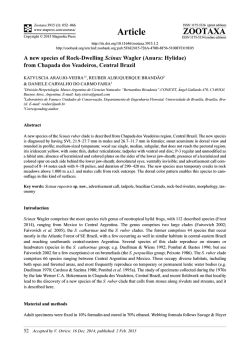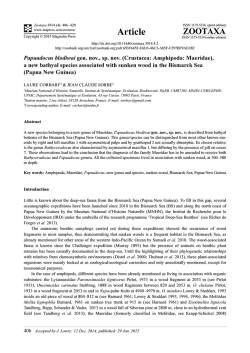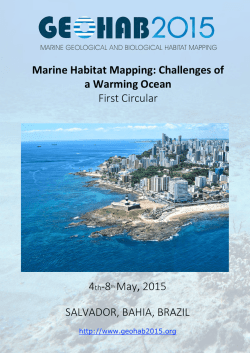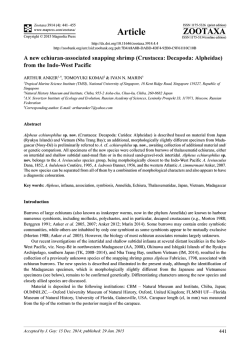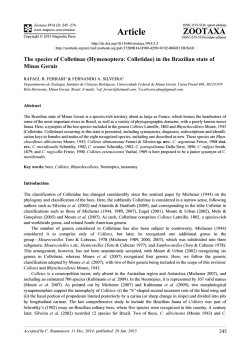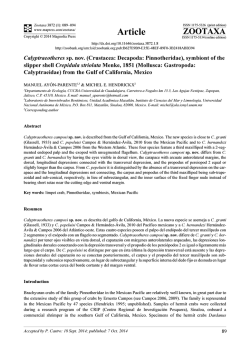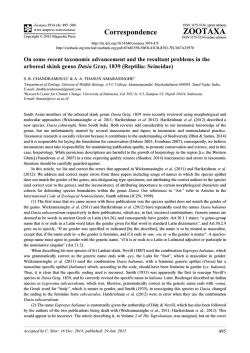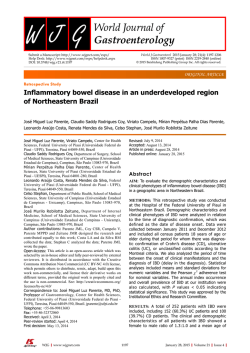
Advertisement call and morphological variation of
Zootaxa 3915 (1): 099–110 www.mapress.com /zootaxa / Copyright © 2015 Magnolia Press Article ISSN 1175-5326 (print edition) ZOOTAXA ISSN 1175-5334 (online edition) http://dx.doi.org/10.11646/zootaxa.3915.1.4 http://zoobank.org/urn:lsid:zoobank.org:pub:E2B92B12-9D74-458F-8B6F-CB137DE16BBD Advertisement call and morphological variation of the poorly known and endemic Bokermannohyla juiju Faivovich, Lugli, Lourenço and Haddad, 2009 (Anura: Hylidae) from Central Bahia, Brazil PEDRO P. G. TAUCCE1,4, PAULO D. P. PINHEIRO1, FELIPE S. F. LEITE2 & PAULO C. A. GARCIA3 1 Instituto de Biociências, UNESP - Univ Estadual Paulista, Campus Rio Claro, Departamento de Zoologia, Laboratório de Herpetologia, São Paulo, Brasil 2 Universidade Federal de Viçosa, Campus Florestal, Florestal, Minas Gerais, Brasil 3 Laboratório de Herpetologia, Departamento de Zoologia, Instituto de Ciências Biológicas, Universidade Federal de Minas Gerais, Belo Horizonte, Minas Gerais, Brasil 4 Corresponding author. E-mail: [email protected] Abstract Bokermannohyla juiju is a member of the B. martinsi species group and it was described based on one male specimen. In order to enhance the knowledge about the species, we describe its advertisement call and morphological variation, including for the first time data on females. We also provide additional comments about its natural history, geographic distribution, and conservation. The advertisement call of B. juiju consists of a single note, non-pulsed, harmonic structured call emitted several times in a row. Four out of five males were found calling in bromeliads. The female, as it is common in many Bokermannohyla species, presents some morphological features not shared with the males, like a non-hypertrophied forearm and less developed prepollex. Key words: Amphibia, Bioacoustics, Cophomantini, Hylinae, Taxonomy, Espinhaço Range Introduction The genus Bokermannohyla comprises 33 species (Frost, 2014) of hylid frogs occurring only in the Brazilian Atlantic Forest, Cerrado, and Caatinga domains. It includes four species groups, the B. circumdata, B. claresignata, B. martinsi, and B. pseudopseudis groups (Faivovich et al. 2005). Bokermann (1965), proposed the Bokermannohyla martinsi group based on the presence of an extensive hook-like humeral crest and a bifid distal element of prepollex, to accommodate B. martinsi (Bokermann, 1964) and B. langei (Bokermann, 1965). Because Faivovich et al. (2005) only had B. martinsi available for their phylogenetic study of hylid frogs, they could not test the monophyly of this species group. However, relying on the presence of the two morphological character states noted above, they continued to recognize the B. martinsi group. Faivovich et al. (2009) described B. juiju based on a single male specimen (holotype) from Chapada Diamantina, central Bahia, Brazil, with little natural history information. The species lacks a bifid distal element of prepollex, but possesses a hook-like humeral crest. Based on the presence of the latter character state, the authors decided to allocate the species in the B. martinsi group. Recent fieldwork in Chapada Diamantina allowed us to collect additional specimens of Bokermannohyla juiju. In this paper, we describe its advertisement call and morphological variation. We also provide additional comments about its natural history, geographic distribution, and conservation. Material and methods We recorded six specimens of Bokermannohyla juiju at Cachoeira Cachoeirão, Parque Nacional da Chapada Diamantina, municipality of Mucugê, State of Bahia, distant approximately 30 km south of the type locality Accepted by V. Orrico: 16 Dec. 2014; published: 2 Feb. 2015 99 Poorly or non-pigmented gular region is also reported for Bokermannohyla sagarana (Leite et al. 2011), and B. saxicola (Bokermann, 1964). We also examined male and female specimens of B. ahenea, B. caramaschi, B. carvalhoi, B. gouveai (Peixoto & Cruz, 1992), B. hylax, B. ibitiguara, B. izecksohni, B. luctuosa, and B. martinsi (appendix I), and pigmented and non-pigmented gular region did not appear to be a sexually dimorphic character. Regarding the absence of the mental glands in the female exemplar and its presence in all five adult males analyzed, it seems to corroborate the considerations of Brizzi et al. (2003) and discussed by Faivovich et al. (2009), the mental glands may be involved in courtship and mating behavior. The supratympanic fold less developed in females was also reported for Bokermannohyla caramaschii (Napoli, 2005) and for B. pseudopseudis (Pombal & Caramaschi, 1995). In other species of Bokermannohyla we analyzed (cited above), development degree of the supratympanic fold was not a clear character, varying between and within male and female specimens. Duellman & Campbell (1992) mention the thickness of skin in Plectrohyla can be a result of the increase, in number and/or size, of mucous glands. Besides, the preparation of the specimens may also influence the evidence of the supratympanic fold. We think the development of the supratympanic fold could be a fixation artifact, and the sexual dimorphism in this character should be seen with caution in Bokermannohyla species. Geographic Distribution and Conservation. The Espinhaço Range is characterized by high endemic anuran species richness (Leite et al. 2008, Carvalho et al. 2013), where narrowly distributed anuran species restricted to a single mountain range are usual (e.g. Leite et al. 2011; Leite et al. 2012; Barata et al. 2013). Bokermannohyla juiju is known from Serra do Sincorá (Municipalities of Palmeiras and Mucugê), Chapada Diamantina, Espinhaço Range, State of Bahia, northeastern Brazil. The species was not recorded at Serra das Almas, Serra do Itobira and Serra do Bastião (all regional designations of mountain ranges) on the southwestern Chapada Diamantina, suggesting that it is endemic to the highlands of southeastern Chapada Diamantina. The species extent of occurrence measured by a minimum convex polygon (EO, sensu IUCN 2001) has only 30.5 km2. This EO is entirely within the Parque Nacional da Chapada Diamantina (PARNA Chapada Diamatina), a Federal strictly protected area (equivalent to IUCN category II, IUCN 1994) with ca. 1519 km2, which covers most of the range of the Serra do Sincorá. The species could potentially occur in the entire Serra do Sincorá, in areas above 1000/1100 m a.s.l. The Parque Nacional da Chapada Diamantina is one of Brazilian most sought after places for ecotourism in Brazil. Despite being a protected area, the PARNA Chapada Diamatina is poorly structured and supervised. Therefore, unregulated tourism, irresponsible land use and occupation, and fire (intentional, and from agriculture or native pasture management for cattle breeding) are constant threats to B. juiju habitat. Acknowledgments We thank C. Haddad for loaning specimens under his care. M. Lindemann, and R. Mourão for field assistance. J. Faivovich , V. Orrico and two anonymous reviewers critically read the manuscript. P. Rocha helped constructing sound figures. J. Parreiras took fixed specimens pictures. P. Taucce thanks CAPES and P. Pinheiro thanks Fapemig for fellowship at Programa de Pós-Graduação em Zoologia at Universidade Federal de Minas Gerais. They both also thank CNPq for the fellowship at Programa de Pós-Graduação em Ciências Biológicas (Zoologia) at Universidade Estadual Paulista, which partially funded this project. F. Leite and P. Garcia thank Vale/FAPEMIG for financial support and P. Garcia thanks CNPq for the fellowship. Literature cited Barata, I.M., Santos, M.T.T., Leite, F.S.F. & Garcia, P.C.A. (2013) A new species of Crossodactylodes (Anura: Leptodactylidae) from Minas Gerais, Brazil: first record of genus within the Espinhaço Mountain Range. Zootaxa, 3731 (4), 552–560. http://dx.doi.org/10.11646/zootaxa.3731.4.7 Bokermann, W.C.A. (1964) Dos nuevas especies de Hyla de Minas Gerais y notas sobre Hyla alvarengai Bok. (Amphibia, Salientia, Hylidae). Neotropica, 10, 67–76. Bokermann, W.C.A. (1965) Hyla langei, a new frog from Paraná, southern Brasil. Journal of the Ohio Herpetological Society, 5, 49–51. ADVERTISEMENT CALL AND VARIATION OF B. JUIJU Zootaxa 3915 (1) © 2015 Magnolia Press · 107 http://dx.doi.org/10.2307/1562630 Bokermann, W.C.A. & Sazima, I. (1973) Anfíbios da Serra do Cipó, Minas Gerais, Brasil. 1—Espécies novas de Hyla (Anura, Hylidae). Revista Brasileira de Biologia, 33, 329–336. Brandão, R.A., Magalhães, R.F., Garda, A.A., Campos, L.A., Sebben, A. & Maciel, N.M. (2012) A new species of Bokermannohyla (Anura: Hylidae) from highlands of Central Brasil. Zootaxa, 3527, 28–42. Brizzi, R., Delfino, G. & Jantra, S. (2003) An overview of breeding glands. In: Jamieson, B.G.M. (Ed.), Reproductive Biology and Phylogeny of Anura. Science Publishers, New Hampshire, USA, pp. 253–317. Cardoso, A.J. (1983) Descrição e biologia de uma nova espécie de Hyla Laurenti, 1768 (Amphibia, Anura, Hylidae). Iheringia, Série Zoologia, 62, 37–45. Cardoso, A.J. & Andrade, G.V. (1982) Nova espécie de Hyla do Parque Nacional Serra da Canastra (Anura, Hylidae). Revista Brasileira de Biologia, 42, 589–593. Carvalho, T.R., Giaretta, A.A. & Magrini, L. (2012) A new species of the Bokermannohyla circumdata group (Anura: Hylidae) from southeastern Brazil, with biocaustic data on seven species of the genus. Zootaxa, 3321, 37–55. Carvalho, T.R. & Giaretta, A.A. (2013) A reappraisal of the geographic distribution of Bokermannohyla sazimai (Cardoso and Andrade, 1982) (Anura: Hylidae) through morphological and bioacoustics approaches. Phyllomedusa: Journal of Herpetology, 12, 33–45. http://dx.doi.org/10.11606/issn.2316-9079.v12i1p33-45 Carvalho, T.R., Leite, F.S.F. & Pezzuti, T.L. (2013) A new species of Leptodactylus, Fitzinger (Leptodactylinae, Leptodactylidae, Anura) from montane rock fields of the Chapada Diamantina, northeastern Brazil. Zootaxa, 3701 (3), 349–364. http://dx.doi.org/10.11646/zootaxa.3701.3.5 Carvalho, T.R., Teixeira, B.F.V., Martins, L.B. & Giaretta, A.A. (2013) New bioacoustic and distributional data on Bokermannohyla sapiranga Brandão et al., 2012 (Anura: Hylidae): revisiting its diagnosis in comparison with B. pseudopseudis (Miranda-Ribeiro, 1937). Zootaxa, 3746 (2), 383–392. http://dx.doi.org/10.11646/zootaxa.3746.2.8 Cocroft, R.B. & Ryan, M.J. (1995) Patterns of advertisement call evolution in toads and chorus frogs. Animal Behaviour, 49, 283–303. http://dx.doi.org/10.1006/anbe.1995.0043 Duellman, W.E. & Campbell, J.A. (1992) Hylid frogs of the genus Plectrohyla: systematics and phylogenetic relationships. Miscellaneous Publications, Museum of Zoology, University of Michigan, 181, 1–32. Duellman, W.E. & Trueb, L. (1986) Biology of Amphibians. The Johns Hopkins University Press, Baltimore, USA, 670 pp. Eterovick, P.C. & Brandão, R.A. (2001) A description of the tadpoles and advertisement calls of members of the Hyla pseudopseudis group. Journal of Herpetology, 35, 442–450. http://dx.doi.org/10.2307/1565962 Faivovich, J., Haddad, C.F.B., Garcia, P.C.A., Frost, D.R., Campbel, J.A. & Wheeler, W.C. (2005) Systematic review of the frog family Hylidae, with special reference to Hylinae: phylogenetic analysis and taxonomic revision. Bulletin of the American Museum of Natural History, 294, 1–240. http://dx.doi.org/10.1206/0003-0090(2005)294[0001:srotff]2.0.co;2 Faivovich, J., Lugli, L., Lourenço, A.C.C. & Haddad, C.F.B. (2009) A new species of the Bokermannohyla martinsi group from central Bahia, Brazil with comments on Bokermannohyla (Anura: Hylidae). Herpetologica, 65, 303–310. http://dx.doi.org/10.1655/0018-0831-65.3.303 Frost, D.R. (2014) Amphibian Species of the World: an Online Reference. Version 6.0. Available at http://research.amnh.org/ herpetology/amphibia/index.html. American Museum of Natural History, New York, USA. Available from: http:// www.webcitation.org/6NX6QyjOh (accessed on 20 February 2014) Gerhardt, H.C. & Mudry, K.M. (1980) Temperature Effects on Frequency Preferences and Mating Call Frequencies in the Green Treefrog, Hyla cenerea (Anura: Hylidae). Journal of Compared Physiology, 137, 1–6. Heyer, W.R., Rand, A.S., Cruz, C.A.G., Peixoto, O.L. & Nelson, C.E. (1990) Frogs of Boracéia. Arquivos de Zoologia, 31, 235–410. http://dx.doi.org/10.2307/1446606 IUCN (1994) Guideline for protected area management categories. CNPPA with the assistance of the WCMC. IUCN, Gland, Switzerland and Cambridge, UK, 261 pp. IUCN (2001) IUCN Red List Categories and Criteria: Version 3.1. IUCN Species Survival Commission. IUCN, Gland, Switzerland and Cambridge, UK, 30 pp. Jim, J. & Caramaschi, U. (1979) Uma nova espécie de Hyla da região de Botucatu, São Paulo, Brasil (Amphibia, Anura). Revista Brasileira de Biologia, 40, 717–719. Leite, F.S.F., Juncá, F.A. & Eterovick, P.C. (2008) Status do conhecimento, endemismo e conservação de anfíbios anuros da Cadeia do Espinhaço, Brasil. Megadiversidade, 4, 158–176. Leite, F.S.F., Pezzuti, T.L. & Drummond, L.O. (2011) A new species of Bokermannohyla from the Espinhaço range, state of Minas Gerais, Southeastern Brazil. Herpetologica, 67, 440–448. http://dx.doi.org/10.1655/herpetologica-d-11-00017.1 Leite, F.S.F., Pezzuti, T.L. & Garcia, P.C.A. (2012) A new species of the Bokermannohyla pseudopseudis group from the 108 · Zootaxa 3915 (1) © 2015 Magnolia Press TAUCCE ET AL. Espinhaço range, central Bahia, Brazil (Anura: Hylidae). Herpetologica, 68, 401–409. http://dx.doi.org/10.1655/herpetologica-d-11-00006.1 Ligges, U., Krey, S., Mersmann, O. & Schnackenberg, S. (2013) tuner: Analysis of music. Available from: http://r-forge.rproject.org/projects/tuner/ (accessed 30 Nov 2014) Lima, N.G.S., Gontijo, A.S.B. & Eterovick, P.C. (2014) Breeding behaviour of Bokermannohyla nanuzae (Anura: Hylidae) at an Atlantic Forest site in southeastern Brazil. Journal of Natural History, 48, 1439–1452. http://dx.doi.org/10.1080/00222933.2013.840940 Lugli, L. & Haddad, C.F.B. (2006a) New species of Bokermannohyla (Anura, Hylidae) from Central Bahia, Brazil. Journal of Herpetology, 40, 7–15. http://dx.doi.org/10.1670/67-05a.1 Lugli, L. & Haddad, C.F.B. (2006b) New species of the Bokermannohyla pseudopseudis group from central Bahia, Brazil (Amphibia, Hylidae). Herpetologica, 62, 453–465. http://dx.doi.org/10.1655/0018-0831(2006)62[453:ansotb]2.0.co;2 Miranda-Ribeiro, A. (1937) Alguns Batrachios Novos das Collecções do Museu Nacional. O Campo, 8, 66–69. Napoli, M.F. (2005) A new species allied to Hyla circumdata (Anura: Hylidae) from Serra da Mantiqueira, southeastern Brazil. Herpetologica, 61, 63–69. http://dx.doi.org/10.1655/03-41 Napoli, M.F. & Caramaschi, U. (2004) Two new species of the Hyla circumdata group from Serra do Mar and Serra da Mantiqueira, southeastern Brazil, with description of the advertisement call of Hyla ibitipoca (Anura, Hylidae). Copeia, 2004, 534–545. http://dx.doi.org/10.1643/ch-02-079r1 Napoli, M.F. & Juncá, F.A. (2006) A new species of the Bokermannohyla circumdata group (Amphibia: Anura: Hylidae) from Chapada Diamantina, state of Bahia, Brazil. Zootaxa, 1244, 57–68. Napoli, M.F. & Pimenta, B.V.S. (2003) Nova espécie do grupo de Hyla circumdata (Cope, 1870) do sul da Bahia, Brasil (Amphibia, Anura, Hylidae). Arquivos do Museu Nacional, 61, 189–194. Napoli, M.F. & Pimenta, B.V.S. (2009) A new species of the Bokermannohyla circumdata group (Anura: Hylidae) from the Coastal Forests of Bahia, Northeastern Brazil. Copeia, 2009, 674–683. http://dx.doi.org/10.1643/ch-08-224 Peixoto, O.L. & Cruz, C.A.G. (1992) New species of Hyla from the "Serra da Mantiqueira, Itatiaia, Rio de Janeiro" State– (Amphibia, Anura, Hylidae) (Nova espécie da Hyla da Serra da Mantiqueira, Itatiaia, Estado do Rio de Janeiro– (Amphibia, Anura, Hylidae). Memórias do Instituto Oswaldo Cruz, 87, 197–200. http://dx.doi.org/10.1590/s0074-02761992000500037 Pinheiro, P.D.P., Taucce, P.P.G., Leite, F.S.F. & Garcia, P.C.A. (2014) The advertisement call of the endemic Bokermannohyla martinsi (Bokermann, 1964) (Anura: Hylidae) from southern Espinhaço range, southeastern Brazil. Zootaxa, 3815 (1), 147–150. http://dx.doi.org/10.11646/zootaxa.3815.1.11 Pombal, J.P. & Caramaschi, U. (1995) Posição taxonômica de Hyla pseudopseudis Miranda-Ribeiro, 1937 e Hyla saxicola Bokermann, 1964 (Anura, Hylidae). Boletim do Museu Nacional. Nova Serie, Zoologia, 363, 1–8. R Core Team (2014) R: A language and environment for statistical computing. R Foundation for Statistical Computing, Vienna, Austria. Available from: URL: http://www.R-project.org/ (accessed 30 Nov 2014) Stannard, B.L. (1995) Flora of the Pico das Almas, Chapada Diamantina, Bahia. Royal Botanic Gardens, Kew, UK, 853 pp. Sueur, J., Aubin, T. & Simonis, C. (2008) Seewave: a free modular tool for sound analysis and synthesis. Bioacoustics, 18, 213–226. http://dx.doi.org/10.1080/09524622.2008.9753600 Toledo, L.F., Martins, I.A., Bruschi, D.P., Passos, M.A., Alexandre, C. & Haddad, C.F.B. (2014) The anuran calling repertoire in the light of social contexto. Acta ethologica, Online First PDF, 13 pp. Vasconcelos, M.F. (2011) O que são campos rupestres e campos de altitude nos topos de montanha do Leste do Brasil? Revista Brasileira de Botânica, 34, 241–246. http://dx.doi.org/10.1590/s0100-84042011000200012 APPENDIX I. Specimens examined. Bokermannohyla juiju: BRAZIL: BAHIA: Mucugê: UFMG 4991–4996. B. ahenea: BRAZIL: SÃO PAULO: Areias: CFBH 33896, 33900, 33996, 33997. São José do Barreiro: CFBH 17517, 18111, 18112, 18122, 18123, 19261, 21953, 28796–28799. B. caramaschi: BRAZIL: ESPÍRITO SANTO: Alegre: CFBH 25103, 25137. Cariacica: CFBH 22497. Domingos Martins: CFBH 10843, 22845, 22846, 30485, 30486, 32550. Santa Teresa: CFBH 22482–22484, 30685. Vargem Alta: CFBH 25088, 25581–25583. B. carvalhoi: BRAZIL: RIO DE JANEIRO: Teresópolis: CFBH 22010, 22011, 24775, 30925–30927, 30936, 30939, 32571. B. gouveai: BRAZIL: MINAS GERAIS: Itamonte: 10126, 16677–16680, 16690, 16691, 35016. ADVERTISEMENT CALL AND VARIATION OF B. JUIJU Zootaxa 3915 (1) © 2015 Magnolia Press · 109 B. hylax: BRAZIL: PARANÁ: Morretes: CFBH 21924. SANTA CATARINA: Anitápolis: CFBH 18191–18193. Blumenau: CFBH 27517. Siderópolis: CFBH 25722. Urussanga: CFBH 11255. SÃO PAULO: Cubatão: CFBH 11545. Eldorado: CFBH 12345, 12347, 12349. Ilhabela: CFBH 7756, 10674, 15260–15262, 15265, 15266, 17402. Itatins: CFBH 23695. Peruíbe: CFBH 13795. Piedade: CFBH 23260. Pilar do Sul: CFBH 8625, 8627, 8629. Santo André: CFBH 28953. São Luiz do Paraitinga: CFBH 13886, 14788, 14789, 14792, 14794, 14796. São Paulo: 12170. B. ibitiguara: BRAZIL: MINAS GERAIS: Alpinópolis: CFBH 0020. Furnas: CFBH 17317, 17320, 17321, 17324, 17343, 17344. Sacramento: CFBH 31743, 31744, 31746–31752, 31754–31771. São Roque: CFBH 8009–8012. B. izecksohni: BRAZIL: SÃO PAULO: Cotia: CFBH 11652–11654. B. luctuosa: BRAZIL: MINAS GERAIS: Camanducaia: CFBH 11239–11241, 11243–11247, 17559–17561, 17563–17566, 17583, 17585–17595. SÃO PAULO: Campinas: CFBH 30085. Cruzeiro: CFBH 8300–8305. Itapecerica da Serra: 36175. Jundiaí: CFBH 7709. Mauá: CFBH 22633. Ribeirão Branco: CFBH 30908, 30909. São Carlos: CFBH 26857–26860, 26863. B. martinsi: BRAZIL: MINAS GERAIS: Barão de Cocais: UFMG 5784, 10677, 10678. Brumadinho: UFMG 827. Catas Altas: UFMG 752, 5567, 5571, 12546. Congonhas: UFMG 5116. Itabirito: UFMG 762. Mariana: UFMG 3549. Moeda: 3940–3942. Nova Lima: UFMG 6511, 10486. Ouro Preto: UFMG 14975, 14981. Analyzed recordings CBUFMG 359—Bokermannohyla juiju: Vale do Paty, Chapada Diamantina National Park, municipality of Mucugê, state of Bahia. Felipe S. F. Leite recording, unvouchered, 20 January 2010. CBUFMG 361—Bokermannohyla juiju: Vale do Paty, Chapada Diamantina National Park, municipality of Mucugê, state of Bahia. Felipe S. F. Leite recording, call voucher UFMG 4991, 20 January 2010. CBUFMG 367, 368, 370, 371—Bokermannohyla juiju: Cachoeira Cachoeirão, Chapada Diamantina National Park, municipality of Mucugê, state of Bahia. Felipe S. F. Leite recording, unvouchered, 22 January 2010. 110 · Zootaxa 3915 (1) © 2015 Magnolia Press TAUCCE ET AL.
© Copyright 2025
